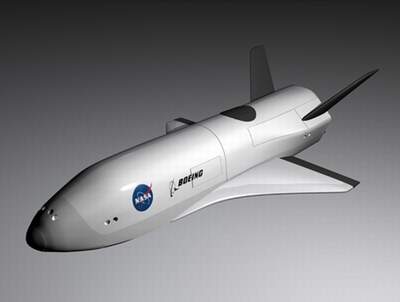Tue, Apr 22, 2003
 Boeing engineers are designing the Orbital Space
Plane (OSP) for NASA utilizing nearly 50 years of expertise in
producing spacecraft. Boeing is one of three contractor teams
developing proposals for the program which includes the spacecraft,
ground operations and all supporting technologies needed to conduct
missions to and from the International Space Station.
Boeing engineers are designing the Orbital Space
Plane (OSP) for NASA utilizing nearly 50 years of expertise in
producing spacecraft. Boeing is one of three contractor teams
developing proposals for the program which includes the spacecraft,
ground operations and all supporting technologies needed to conduct
missions to and from the International Space Station.
 Boeing was awarded a $45 million contract
modification on the NASA Space Launch Initiative program for work
on the space plane. The modification extends the current contract
through July 2004.
Boeing was awarded a $45 million contract
modification on the NASA Space Launch Initiative program for work
on the space plane. The modification extends the current contract
through July 2004.
The Orbital Space Plane will be a multipurpose spacecraft that
can perform crew rescue vehicle and crew transfer vehicle missions
for the space station. It will be compatible with current
expendable rockets and future reusable launch vehicles and will
seat four to six people. “Our experience from Mercury to
Gemini, from Apollo to the space shuttle, gives us significant
knowledge base and proficiency to build upon, “ said Volker
Roth, program manager for Boeing on this program in Huntsville,
Ala. “We are drawing on the best of industry for this
team.”

OSP also draws upon research conducted with the X-37 built by
Phantom Works, the research and development unit of Boeing. The
X-37 (seen below) serves as a test bed for 40 airframe, propulsion
and operational technologies designed to make space transportation
more affordable. Under the Space Launch Initiative, Boeing will
determine a technical and program approach for a future Orbital
Space Plane. The concept definition phase is scheduled to last 16
months and includes a series of systems engineering trade
studies.
 The
results will be more specific definitions and solutions based on
requirements set by NASA. This includes program elements, estimated
life cycle cost for various alternatives and vehicle design
recommendations.
The
results will be more specific definitions and solutions based on
requirements set by NASA. This includes program elements, estimated
life cycle cost for various alternatives and vehicle design
recommendations.
“Space is a challenging environment,” added Roth.
“The Orbital Space Plane will be designed to provide safe,
reliable and affordable access to space for humans.” NASA is
expected to proceed with full-scale development of the OSP before
the end of 2004. In addition to this contract effort, Boeing is
preparing to compete for the next phase of the OSP in 2004. Boeing
Phantom Works will manage the Orbital Space Plane Phase A Program
from facilities in Huntsville, Ala., and will employ about 120
persons in Houston, Huntington Beach, Calif., and the Kennedy Space
Center, Fla.
More News
Pilot Also Reported That Due To A Fuel Leak, The Auxiliary Fuel Tanks Were Not Used On June 4, 2025, at 13:41 eastern daylight time, a Piper PA-23, N2109P, was substantially damage>[...]
Have A Story That NEEDS To Be Featured On Aero-News? Here’s How To Submit A Story To Our Team Some of the greatest new stories ANN has ever covered have been submitted by our>[...]
From 2023 (YouTube Edition): Reflections on War’s Collective Lessons and Cyclical Nature The exigencies of war ought be colorblind. Inane social-constructs the likes of racis>[...]
Aero Linx: Colorado Pilots Association (CPA) Colorado Pilots Association was incorporated as a Colorado Nonprofit Corporation in 1972. It is a statewide organization with over 700 >[...]
High Speed Taxiway A long radius taxiway designed and provided with lighting or marking to define the path of aircraft, traveling at high speed (up to 60 knots), from the runway ce>[...]
 NTSB Prelim: Piper PA-23
NTSB Prelim: Piper PA-23 ANN FAQ: Submit a News Story!
ANN FAQ: Submit a News Story! Classic Aero-TV: One Mans Vietnam
Classic Aero-TV: One Mans Vietnam ANN's Daily Aero-Linx (07.03.25)
ANN's Daily Aero-Linx (07.03.25) ANN's Daily Aero-Term (07.03.25): High Speed Taxiway
ANN's Daily Aero-Term (07.03.25): High Speed Taxiway






